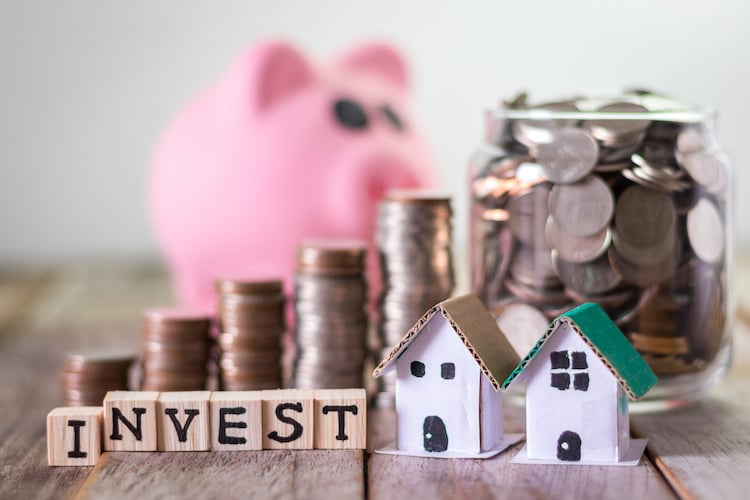Albert Einstein once said that, “Compound interest is the eighth wonder of the world. He who understands it, earns it… He who doesn’t, pays it.” But what does compounding actually mean?
Cash flow, property appreciation, and compounding real estate are three strategies investors use to make money in real estate. In this article, we’ll take a closer look at how compounding in real estate works, and explain why this investing strategy may offer the best of both worlds for rental property investors.
Key takeaways
- Real estate compounding is similar to using dividends from a stock to buy more stock.
- With real estate, you reinvest the profits from one property into additional rental properties.
- A buy-and-hold real estate investor may be able to generate significant wealth by compounding real estate over the long term.
What is compounding?
Compounding occurs when an investor gains additional profits on not only the initial principal invested, but also the profits that have been accumulated from preceding periods. Instead of periodic profits from an investment sitting idle from one period to the next, they are combined to help multiply returns.
When an investor purchases shares of a dividend-paying stock, the broker often offers the option of reinvesting the stock dividends received to buy more stock or crediting the dividend payment to the investor’s cash account. By reinvesting the dividends, an investor is able to compound potential returns over the time the stock is held.
Here’s a simple example of how compounding works. Assume an investor has $50,000 in an asset that pays an annual interest rate of 5%. Over a 5-year holding period, the investment would generate nearly 10% more in additional returns, thanks to the magic of compounding:
| Year 1 | Year 2 | Year 3 | Year 4 | Year 5 | |
| Total Value | $50,000 | $52,000 | $54,600 | $57,330 | $60,197 |
| Interest Paid @ 5% | $2,500 | $2,600 | $2,730 | $2,867 | $3,010 |
If interest were only paid on the initial investment of $50,000, the return over 5 years would be just $12,500 ($2,500 per year x 5 years). However, due to compounding, the investor generated a total return of $13,707, or nearly 10% more profit.
How compounding works in real estate investing
An investor seeking compound returns from real estate may wish to start sooner rather than later. That’s because compounding in real estate doesn’t happen overnight, which is one reason why real estate is often considered a long-term, buy-and-hold investment.
For example, cash flows may be inconsistent from one period to the next due to unexpected repair costs or longer than anticipated vacancies. Although historically home prices rise, they can also go down.
According to this chart from the Federal Reserve, during the Global Financial Crisis of 2007-2009, the median sales price of houses sold decreased by about 20%. Since then, home prices have recovered, increasing by more than 94% over the following 12 years (Q1 2009 to Q3 2021).
Example of compounding real estate
Now let’s look at one example of how a buy-and-hold investor might compound real estate returns over the long term by using the cash flows and equity from one property to buy more.
We’ll assume an investor pays all cash for the 1st property and purchases an additional rental property every 5 years. The 25% down payment is raised from a combination of cash out refinances and coming out of pocket from personal savings.
We’ll also assume that property prices increase an average of 5% per year, and net cash flow is the money remaining after all operating expenses and the mortgages have been paid. Finally, for the purposes of simplifying this example, we’ll assume that rent prices and operating expenses remain unchanged over the entire 20-year holding period.
| Year 1 | Year 5 | Year 10 | Year 15 | Year 20 | |
| Home #1 | $100,000 | $128,000 | $163,300 | $208,500 | $266,000 |
| Net cash flow | $4,800 | $24,000 | $48,000 | $72,000 | $96,000 |
| Home #2 | $128,000 | $163,300 | $208,500 | $266,000 | |
| Net cash flow | $2,600 | $13,000 | $26,000 | $39,000 | |
| Home #3 | $163,300 | $208,500 | $266,000 | ||
| Net cash flow | $3,300 | $16,500 | $33,000 | ||
| Home #4 | $208,500 | $266,000 | |||
| Net cash flow | $4,200 | $21,000 | |||
| Home #5 | $266,000 | ||||
| Net cash flow | $5,300 | ||||
| Total cash flows | $4,800 | $26,600 | $64,300 | $118,700 | $194,300 |
| Total property value | $100,000 | $256,000 | $489,900 | $834,000 | $1,330,000 |
Things to think about when compounding real estate
The above example is based on certain assumptions, such as home prices consistently increasing year-over-year, and rental income and operating expenses remaining the same from one period to the next. However, in the real world of real estate investing, that’s almost never the case.
Some things to consider about real estate compounding include:
- Compounding real estate doesn’t happen overnight and will take time.
- Equity and cash flow from one rental property is being used to purchase additional properties.
- Investments are being used to generate cumulative profits and growth year after year.
- Initially an investor may need to pay for expenses from personal savings when a property does not generate immediate cash flow.
- As a rule of thumb, the long-term increases in property values may outpace cumulative cash flows.
- An investor who begins compounding real estate early may be able to generate significant wealth over the long term.
Tips for compounding your real estate portfolio
Real estate compounding requires a certain amount of time and a lot of discipline. Here are some tips for compounding your real estate portfolio that every investor needs to know.
Small is good
It’s alright to start with a small, inexpensive property instead of trying to save enough money to make a big down payment on an expensive home. The Roofstock Investment Property Marketplace has single-family rental homes listed for sale for less than $100,000. Turnkey rental properties on Roofstock are already rented to a tenant, which means that an investor can begin collecting rental income the day the purchase closes.
Reinvest profits
Another key to successfully compounding real estate is to reinvest the net cash flows collected and money pulled out of a cash out refinance. Think of the profits earned from each rental property as dividends that are meant to be reinvested. With the right mindset, an investor may find that it’s much easier to reinvest profits by pretending that they’ve never had them in the first place.
Force yourself to save
An investor may need to contribute personal funds to compound real estate, especially when just starting out. Cash flow isn’t always consistent, and a lender may require a bigger down payment than expected to approve a rental property loan. Having money set aside can help to keep a real estate compounding strategy on track during times when the market doesn’t work in an investor’s favor.

Other real estate investing strategies to know
Compounding real estate is an investment strategy that combines cash flow with capital growth. An investor may also use each of these techniques individually to generate potential profit from rental property.
Cash flow strategy
With the cash flow strategy, an investor aims to make money mainly from the cash flow a rental property generates. Cash flow in real estate is calculated using the following formula:
- Cash Flow = Gross Rental Income – Operating Expenses – Mortgage Payment
An investor may also wish to take into account tax benefits like depreciation when calculating real estate cash flow. Depreciation is a non-cash deduction the IRS allows a real estate investor to take to reduce pre-tax income.
For example, assume a rental property is worth $110,000 (excluding the value of the land). An investor may depreciate the property over a period of 27.5 years and claim a depreciation expense of $4,000 per year, in addition to deducting operating expenses, property taxes, and mortgage interest:
- $110,000 property value / 27.5 year depreciation schedule = $4,000 annual depreciation expense
Capital growth strategy
The capital growth strategy is based on property value quickly increasing over a short period of time. In some cases, an investor may purchase a property with no cash flow, or even negative cash flow.
To illustrate, assume a rental property is purchased for $100,000 in a real estate market where an investor forecasts home prices to rise by 10% per year. Even though cash flow is negative each year, the investor anticipates making a profit at the end of 5 years when the property is sold:
| Year 1 | Year 2 | Year 3 | Year 4 | Year 5 | |
| Property Value | $100,000 | $110,000 | $121,000 | $133,100 | $146,410 |
| Cash flow | -$2,000 | -$2,000 | -$2,000 | -$2,000 | -$2,000 |
| Total cash flow | -$2,000 | -$4,000 | -$6,000 | -$8,000 | -$10,000 |
At the end of the 5-year holding period, the investor sells the home for $146,410 and makes a profit of $36,410:
- $146,410 sale price - $100,000 original purchase price - $10,000 total negative cash flow = $36,410 anticipated profit
Note that if a property generates negative cash flow, an investor must be prepared to pay for any cash shortages using personal funds or money from other rental properties with positive cash flows.
Closing thoughts
Compounding is a strategy real estate investors use to make money by reinvesting the profits from one property into another property. However, compounding isn’t a strategy for people hoping to get rich quick. By combining cash flow from rental income with property appreciation, an investor may build wealth over the long term with real estate compounding.









